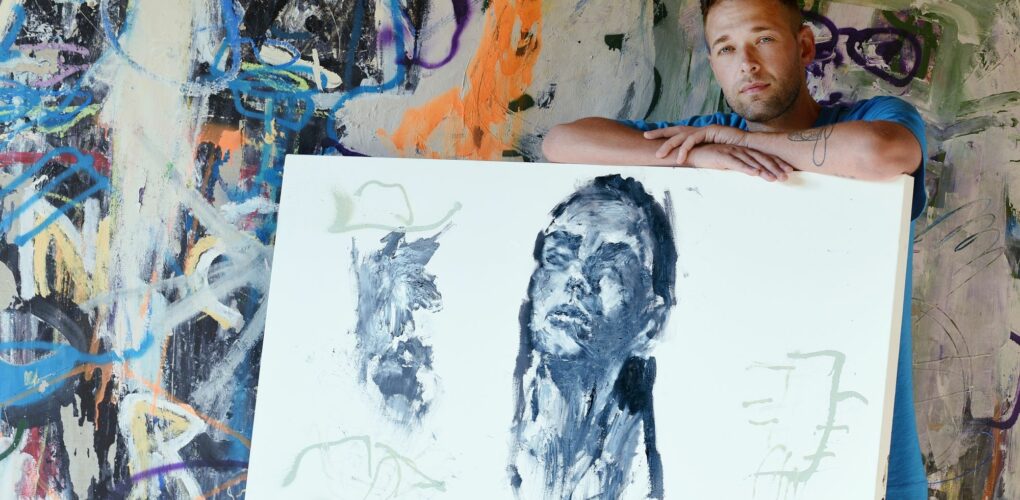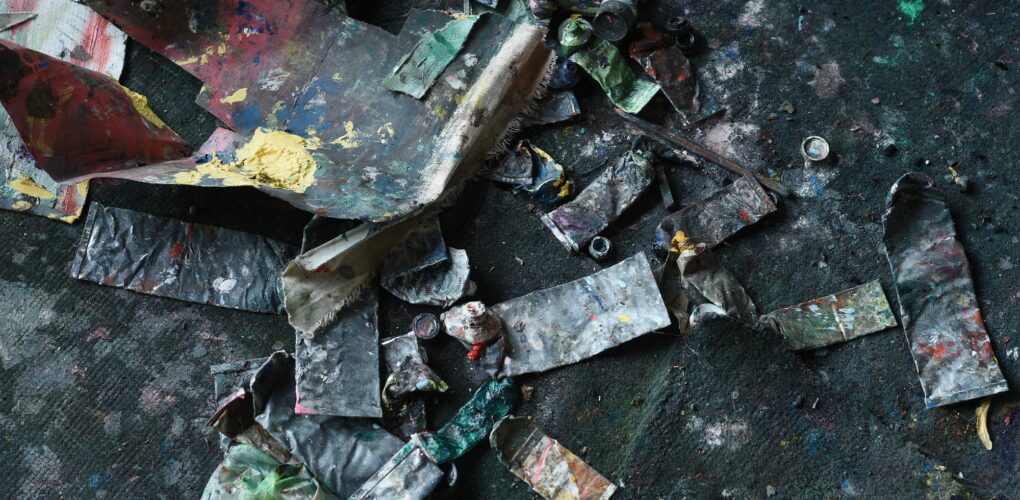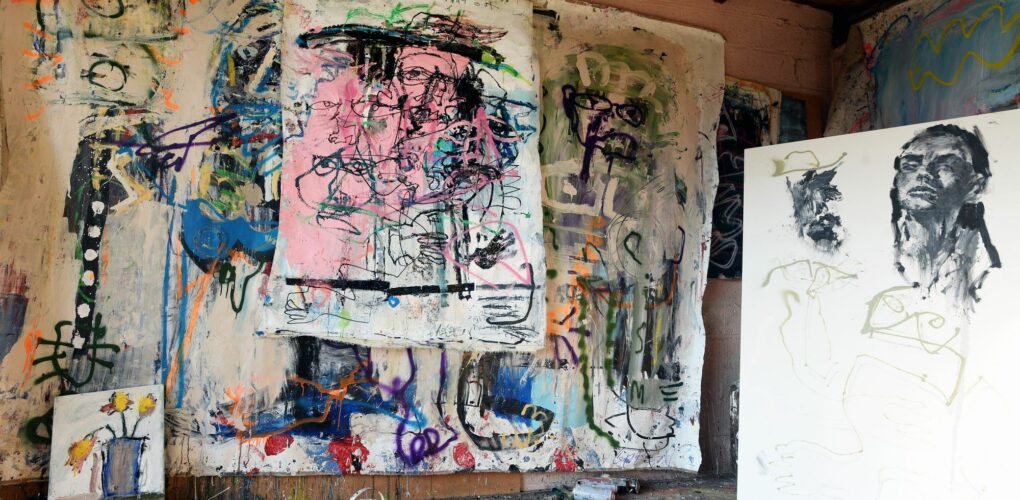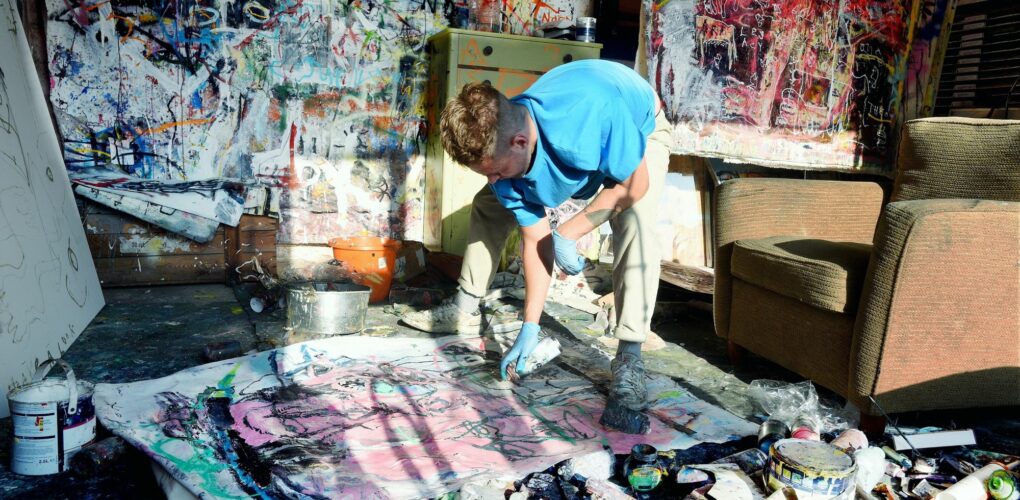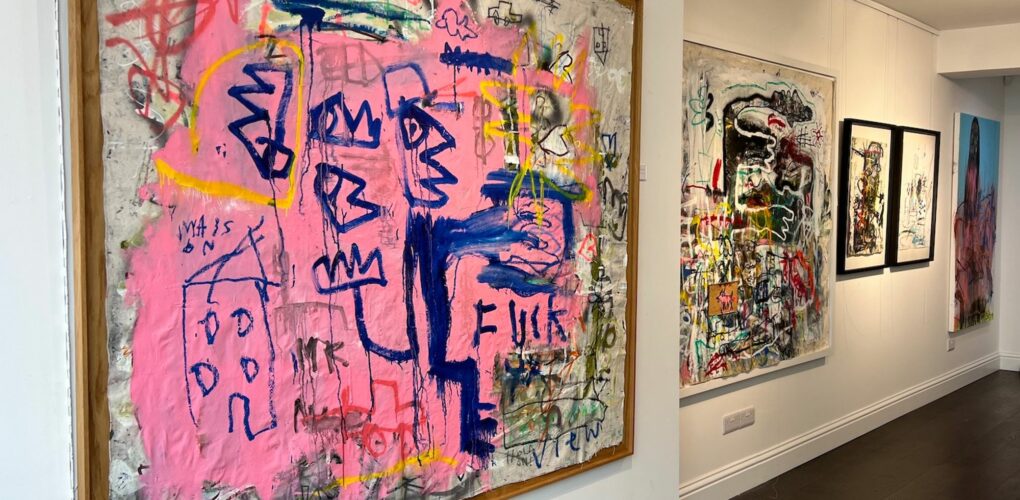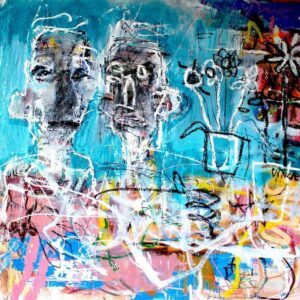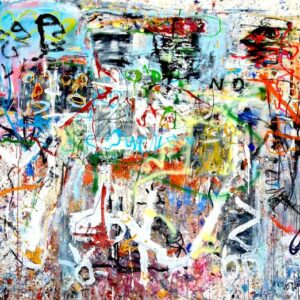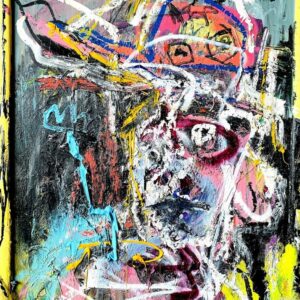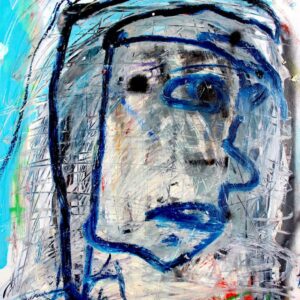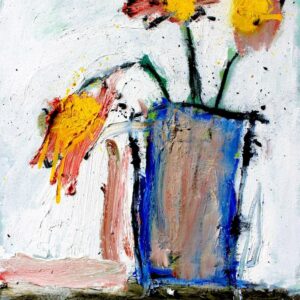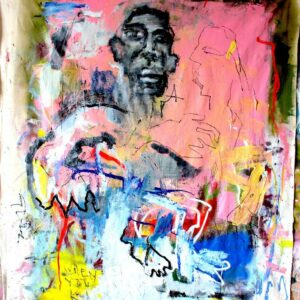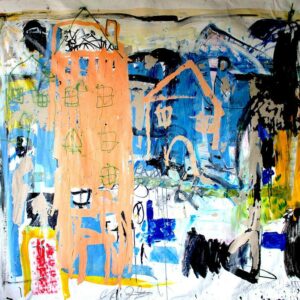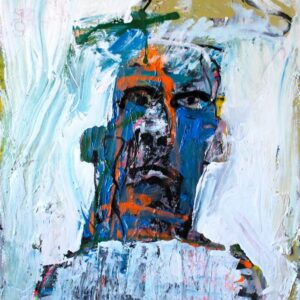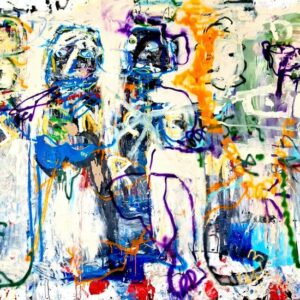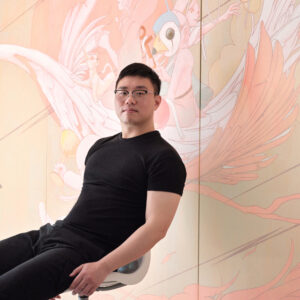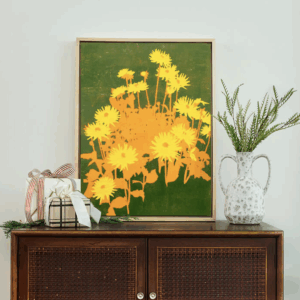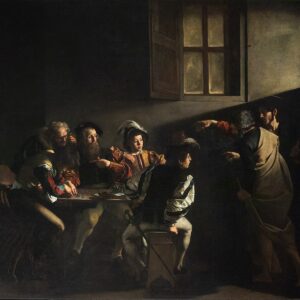One to Watch
 Trust the Process: James Green
Trust the Process: James Green
Based in Stroud, UK, James Green creates enigmatic and spontaneous portraits inspired by the residents of his hometown. James received his degree in Fine Art from the Cardiff School of Art & Design and has since exhibited extensively throughout the United Kingdom and at The Other Art Fair in London. James gives us insight into his intense creative process, artistic inspirations, and playful approach to art.
Tell us about who you are and what you do. What’s your background?
Over the past decade or so, I’ve learned a lot about myself on a personal level, and each day that goes by, I understand who I am that little bit more. It has become a vital part of my professional development as a painter to continually explore what I’m all about with curiosity. As a boy, I was always known as “the kid that could draw.” It was never a strategic decision to become an artist, it’s just what I always have been. Early on, I could only see value in art with a high technical ability. I would spend a month constructing a painterly face to make sure it resembled a subject or sitter precisely with no compromise whatsoever. If the result wasn’t perfect, I’d chuck it in the bin after stamping on it a few times.
Following art school, I took some time to experience life and became much more open-minded. Having lived a little, I realized what ‘art’ actually is. That’s when my approach changed quite dramatically. It wasn’t art school that educated me on what art was, it was life. I’ve since grown to understand that art is simply a case of living authentically. If you’re an artist, your creative output will happen impulsively and obsessively, however that manifests. You don’t choose to do it. You’re run by it.
What does your work aim to say? What are the major themes you pursue in your work? Can you share an example of a work that demonstrates this?
I find it powerful to draw on personal experience. For as long as I can remember, I’ve been somewhat obsessed with painting and drawing faces. Throughout the past decade or so, I’ve naturally become more gestural and expressive in the way I develop faces. My ambition has naturally transformed from precise imagery to a desire to create portraits that are unique to myself and my life, that I could never make again. I got to a point where I found creating highly representational paintings not very creative at all. Nowadays, even a very abstract work of mine could be viewed as a self-portrait. I paint today from a highly personal standpoint and entirely from my imagination in a process that I would call a riot of vivid unpredictability. I have no plan whatsoever when first going into a painting. When the painting is finished, it’s like meeting an old friend for the first time, and it can be a pretty special moment when that happens.
The way that my painting “When You Know, You Know” came together was a special moment for me. As is normally the case, the initial layers of this piece were doing my head in, for want of a better phrase. There’s a lot to be said about trusting the process! Following the creation of the final layer, I sat back and smiled, taking it in for some time. Often, painting can feel like a fight, and I immediately connected with this one as soon as I’d put the brush down.
Can you walk us through your process for creating a work from beginning to end?
I generally prefer to feel slightly out of my depth when painting. I believe ‘art’ shouldn’t be a place to play it safe. I prefer for it to feel like a fight rather than something peaceful. Each day I’ll arrive at the studio, where I am typically presented with around ten works in progress that I’m working on simultaneously. I’ll sit in my chair surrounded by these daunting propositions and take a moment or two in brief meditation with the intention of reconnecting to the present moment. Once I’m in the right headspace, I’ll jump from one canvas to another, making a series of instinctive expressions. Then I sit back, reflect on each piece, and analytically observe any formations trying to emerge. I’ll continue to work using a process of layering to proactively discover if these formations are destined to become part of the final layer. Sometimes they crawl back into formlessness, and sometimes they become something final. Some works are finished in 20 minutes, and some in a year or two.
Who are your biggest influences and why?
It’s the people within my community that inspire me most significantly. Stroud (Cotswolds, UK) is full of fascinating people with unique thinkers from all walks of life. Having grown up here, it took living and traveling away to realize how unique Stroud really is. My art is inevitably informed by our place and people, the untampered commons I walk through each day, and those I meet and connect with. When it comes to visual artists alive today, I’m most influenced by artists who approach visual work with the essence of play. Art should be at least a little fun, in my opinion. Rob Ober is a good example of this. Although playful, his works have a remarkable sophistication to their composition. My good friends Monsieur Jamin Paris and Brian Gassaway also deserve a mention. They are true artists in every sense of the word. When it comes to influences who have passed, I’ve been a long-standing fan of Francis Bacon. He hit the nail on the head with the whole “art should be powerful before it is beautiful” thing. Also, a musician I’m hugely inspired by is Tricky, once of Bristol’s Massive Attack. It’s clear that his music is a direct reflection and extension of who he is. I enjoy painting to his music.
How does your work comment on current social and political issues?
As a painter, it’s inevitable that my work is subconsciously informed by the wider social and political landscape in one way or another. Although I try not to watch the news every day, when we as a society go through challenging times, it’s impossible that these experiences don’t become some part of my onward perspective and creative output. A good example is when we were going through the global pandemic due to the Covid-19 outbreak. It was 2021 at this point, and I had been wanting to acknowledge the global lockdowns in some way for a little while; however, I didn’t want to force anything too contrived and obvious.
My painting titled “Inverted Hope” happened organically and felt like the desired authentic expression. The canvas itself was torn from my studio wall at the start of the first lockdown, crumpled into a ball, and walked all over by me until the start of its creation. Trodden into the studio floor, this felt like the most appropriate surface for this pursuit as it told part of my personal lockdown story spent in the studio.
How do you hope viewers respond to your works? What do you want them to feel?
As long as I’ve made them feel something, I’ve done my job. I don’t mind at all if someone hates them. At least that way, I have provoked an emotion as extreme as those emitted during the creative process. Creating in the way that I do today ensures that each piece of work is unique to that specific moment and that moment alone, which is why I’m content with the output no matter how others receive it. I sometimes love the outcome, but the “getting there” matters more to me than the result and external response to the work.
What are some of your favorite experiences as an artist?
The best thing about this career is, by far, the people I’m fortunate to meet. Without art, I wouldn’t have the wonderfully broad friendship circle I am blessed with. Collectors often become friends of mine, which, on reflection, I wonder may be due to the work saying something about themselves on a meaningful level. It’s no wonder we’re often similarly minded and end up friends. One example of a connection I’m hugely grateful for is a remarkable friendship and collaborative project with Paris artist Monsieur Jamin. This is an incredibly unique connection rooted entirely in the visual. We don’t speak a word of each other’s language. It’s a pretty unique situation to be able to sit opposite someone over dinner, not verbally communicate, and for it not to be remotely awkward.
What was the best advice given to you as an artist?
“Always feel like you’re drowning.” A renowned artist whom I have a great deal of respect for once gave me this advice. He was insistent on not expanding further on these words. I drew from it that I should always be out of my comfort zone when it comes to painting and never feel as though I have arrived at the final destination. It’s my experience that this can help you to actively occupy the space between the borders of what is considered normal or acceptable, which I feel can be an incredible catalyst for genuinely challenging work. I never want to feel like I’ve ‘got there’ or found ‘my place.’ That way, I imagine, there won’t be much room for regret down the line!
